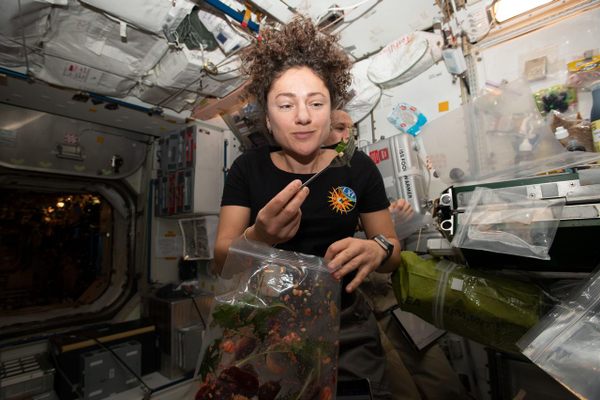When NASA Wasn’t Sure if Astronauts Could Swallow in Space
Early space sustenance resembled baby food.

As humanity prepares for years-long missions to Mars, a major question has been raised: How will astronauts have enough to eat and drink in space? There’s talk of hydroponic growth labs, where sweet potatoes and beans might grow on the Red Planet, and kitchen appliances that remain functional in partial gravity.
While astronauts can chew and swallow in outer space the same way we do here on Earth (minus the matter of floating food, of course), during the early space missions, it wasn’t entirely clear if they could do so normally. What made NASA doubt astronauts’ ability to ingest and digest food? Vickie Kloeris, who manages the ISS food systems at NASA, says the concern likely stemmed from whether or not peristalsis—or, the involuntary muscle contractions that move food through the digestive tract—could still happen. “I guess they were concerned that in microgravity … that system might not work without the assistance of gravity,” she says.
NASA then tested astronauts’ ability to chew and swallow on the Project Mercury flights from 1961 to 1963. During missions that lasted from a few minutes to one entire day, they introduced a limited selection of sustenance out of aluminum tubes. The initial Mercury flights were short enough that astronauts didn’t need to eat entire meals. But according to the U.S. Army Natick Research and Development Laboratories (which assisted in designing the food program for several NASA flights, including Project Mercury), eating on the Mercury flights was critical to garnering “gross information as to the effect of null gravity on food ingestion and digestion.”

Luckily, when John Glenn took food on the Friendship 7 spacecraft in February 1962, he was able to swallow his pureed applesauce. Later that year, when Wally Schirra orbited the Earth six times in the Sigma 7, eating was implemented into his nine-hour flight plan. Schirra didn’t seem to have much of an appetite, saying: “I’m having a ball up here drifting.” Yet he followed the plan anyway, slurping on peaches and squishy ground beef from squeeze tubes.
The idea is that since peristalsis happens despite gravitational shifts, astronauts can eat and drink in space. (It’s the same reason why you’re able to swallow water, even when upside down.) “I’m not sure what they would have done if that had been a problem,” Kloeris says. “I don’t think they had a plan B.”
Eating only soft foods quickly becomes tiresome for astronauts, of course, and space food has come a long way. These days, Kloeris says the International Space Station larder boasts about 200 different foods and drinks, ranging from frozen shrimp cocktails to cherry-blueberry cobbler, that are developed by the Space Food Systems Laboratory.
According to Kloeris, hot sauce is one of the most popular items on board, because many astronauts report dulled taste buds in orbit. She suspects this happens because they eat food out of packages instead of using a plate. “In microgravity, when you heat something, it can dissipate in different directions,” she says. “You’re in an enclosed environment with a lot of other competing odors, so all of that taken together, it’s not too surprising that some crew remembers report that flavor is not as intense up there.”
Yet one fear from those early days still rings true in space today: Some foods contain too many crumbs that could float off and damage equipment. During the Mercury mission, some snacks were even coated with gelatin to prevent crumbs from flying away. So when astronauts are staring at the big blue marble from above, they may be dreaming of a good, crusty bread.
Gastro Obscura covers the world’s most wondrous food and drink.
Sign up for our regular newsletter.


























Follow us on Twitter to get the latest on the world's hidden wonders.
Like us on Facebook to get the latest on the world's hidden wonders.
Follow us on Twitter Like us on Facebook